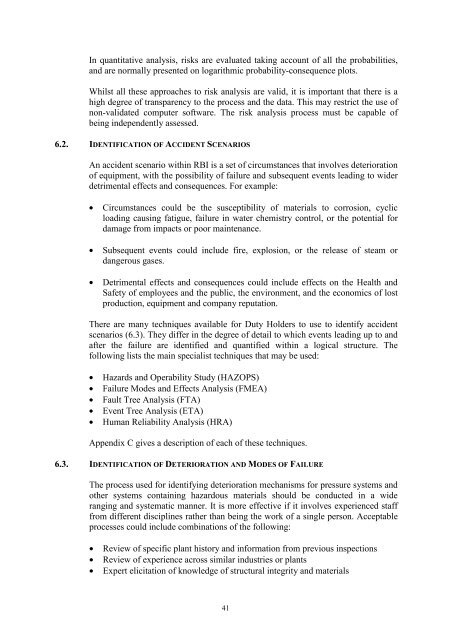Best Practice for Risk Based Inspection
risk based inspection
risk based inspection
Create successful ePaper yourself
Turn your PDF publications into a flip-book with our unique Google optimized e-Paper software.
In quantitative analysis, risks are evaluated taking account of all the probabilities,<br />
and are normally presented on logarithmic probability-consequence plots.<br />
Whilst all these approaches to risk analysis are valid, it is important that there is a<br />
high degree of transparency to the process and the data. This may restrict the use of<br />
non-validated computer software. The risk analysis process must be capable of<br />
being independently assessed.<br />
6.2. IDENTIFICATION OF ACCIDENT SCENARIOS<br />
An accident scenario within RBI is a set of circumstances that involves deterioration<br />
of equipment, with the possibility of failure and subsequent events leading to wider<br />
detrimental effects and consequences. For example:<br />
• Circumstances could be the susceptibility of materials to corrosion, cyclic<br />
loading causing fatigue, failure in water chemistry control, or the potential <strong>for</strong><br />
damage from impacts or poor maintenance.<br />
• Subsequent events could include fire, explosion, or the release of steam or<br />
dangerous gases.<br />
• Detrimental effects and consequences could include effects on the Health and<br />
Safety of employees and the public, the environment, and the economics of lost<br />
production, equipment and company reputation.<br />
There are many techniques available <strong>for</strong> Duty Holders to use to identify accident<br />
scenarios (6.3). They differ in the degree of detail to which events leading up to and<br />
after the failure are identified and quantified within a logical structure. The<br />
following lists the main specialist techniques that may be used:<br />
• Hazards and Operability Study (HAZOPS)<br />
• Failure Modes and Effects Analysis (FMEA)<br />
• Fault Tree Analysis (FTA)<br />
• Event Tree Analysis (ETA)<br />
• Human Reliability Analysis (HRA)<br />
Appendix C gives a description of each of these techniques.<br />
6.3. IDENTIFICATION OF DETERIORATION AND MODES OF FAILURE<br />
The process used <strong>for</strong> identifying deterioration mechanisms <strong>for</strong> pressure systems and<br />
other systems containing hazardous materials should be conducted in a wide<br />
ranging and systematic manner. It is more effective if it involves experienced staff<br />
from different disciplines rather than being the work of a single person. Acceptable<br />
processes could include combinations of the following:<br />
• Review of specific plant history and in<strong>for</strong>mation from previous inspections<br />
• Review of experience across similar industries or plants<br />
• Expert elicitation of knowledge of structural integrity and materials<br />
41



